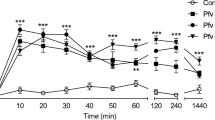Abstract
Arachidonic acid (AA) injected into hindpaws of Lewis rats produces a severe edematous response. Treatment with corticosteroids (dexamethasone, prednisolone), dual inhibitors of arachidonate metabolism (phenidone, SK & F 86002), anti-histamine/serotonin agents (chlorpheniramine, cyproheptadine) and a gold compound (auranofin) inhibited AA-induced edema. In contrast, administration of high doses of cyclooxygenase inhibitors (indomethacin, piroxicam, naproxen, ibuprofen, meclofenamic acid and tiflamizole) did not affect AA-induced hind paw edema. The involvement of lipoxygenase products and mast cell mediators in the edematous response to arachidonic acid render this model potentially useful for studying antiinflammatory agents with a mechanism of action different from that of cyclooxygenase inhibitors.
Similar content being viewed by others
References
E. M. Davidson,Leukotriene B 4,a mediator of inflammation present in synovial fluid in rheumatoid arthritis. Ann. Rheum. Dis.42, 677–679 (1983).
J. T. O'Flaherty,Biology of disease, lipid mediators of inflammation and allergy. Lab. Invest.47, 314–329 (1982).
J. M. Young, D. A. Spires, C. J. Bedford, B. Wagner, S. J. Ballaron and L. M. DeYoung,The mouse ear inflammatory response to topical arachidonic acid. J. Invest. Dermatol.82, 367–371 (1984).
R. P. Carlson, L. O'Neill-Davis, J. Chang and A. J. Lewis,Modulation of mouse ear edema by cyclooxygenase and lipoxygenase inhibitors and other pharmacologic agents. Agents and Actions17, 197–204 (1985).
K. D. Rainsford,Comparison of the gastric ulcerogenic activity of new non-steroid antiinflammatory drugs in stressed rats. Br. J. Pharmacol.73, 226P-227P (1981).
G. J. Blackwell and R. J. Flower,1-Phenyl-3-pyrazolidone: An inhibitor of cyclic-oxygenase and lipoxygenase pathways in lung and platelets. Prostaglandins16, 417–425 (1978).
D. E. Griswold, P. J. Marshall, E. F. Webb, R. Godfrey, J. Newton, M. J. DiMartino, H. Sarau, J. Gleason, G. Poste and N. Hanna,SK&F 86002: a structurally novel anti-inflammatory agent that inhibits lipoxygenase- and cyclooxygenase-mediated metabolism of arachidonic acid. Biochem. Pharmacol. In Press (1987).
D. T. Walz, M. J. DiMartino, L. W. Chakrin, B. M. Sutton and A. Misher,Antiarthritic properties and unique pharmacologic profile of a potential chrysotherapeutic agent: SK&F D-39162. J. Pharmacol. Exp. Therap.197, 142–152 (1976).
Author information
Authors and Affiliations
Additional information
Mail Code: L-101
Rights and permissions
About this article
Cite this article
DiMartino, M.J., Campbell, G.K., Wolff, C.E. et al. The pharmacology of arachidonic acid-induced rat paw edema. Agents and Actions 21, 303–305 (1987). https://doi.org/10.1007/BF01966498
Issue Date:
DOI: https://doi.org/10.1007/BF01966498




